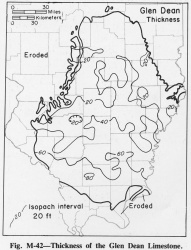Glen Dean Limestone
Lithostratigraphy: Pope Megagroup >>Okaw Group >>Glen Dean Limestone
Chronostratigraphy: Paleozoic Erathem >>Mississippian Subsystem >>Chesterian Series >>Hombergian Stage
Allostratigraphy: Kaskaskia Sequence
Primary source
Willman, H. B., Elwood Atherton, T. C. Buschbach, Charles Collinson, John C. Frye, M. E. Hopkins, Jerry A. Lineback, and Jack A. Simon, 1975, Handbook of Illinois Stratigraphy: Illinois State Geological Survey Bulletin 95, 261 p.
Contributing author(s)
Elwood Atherton, Charles Collinson, and Jerry A. Lineback
Name
Original description
Glen Dean Limestone (Butts, 1917, p. 97-102).
Derivation
Named for the town of Glen Dean, Breckenridge County, Kentucky.
Other names
History/background
Type section
Type location
The type section of the Glen Dean Limestone is in exposures along a railroad (abandoned) on both sides of the town of Glen Dean, Breckenridge County, Kentucky.
Type author(s)
Type status
Reference section
Reference location
Reference author(s)
Reference status
Stratigraphic relationships
Extent and thickness
The Glen Dean is a limestone-shale unit that thickens from 5-15 feet in the north to 65-80 feet in the south (fig. M-42).
Lithology
In subsurface the top and base of the Glen Dean are put at the limits of well defined limestone strata. In the south, the Glen Dean typically has a threefold division into upper and lower limestone units separated by shale. In a few places a shale lens occurs in the lower limestone. Farther north only the lower limestone unit is generally present, and the formation is correspondingly thinner. In general, where the Glen Dean is relatively thick it contains a higher proportion of shale. The Glen Dean has fairly rapid lateral variations in thickness and in limestone-shale ratio, particularly in the upper two units, and boundaries between the subdivisions are not consistent throughout large areas. The Glen Dean is composed of limestone and various amounts of dolomite and shale. The limestone is light to medium brownish gray, coarse grained, and fossiliferous. Parts of it are oolitic and some beds are cherty. Well developed oolitic limestone is rare in younger Chesterian limestones. The shales are dark greenish gray and are generally fossiliferous.
Core(s)
Photograph(s)
Contacts
Well log characteristics
Fossils
The bryozoan Prismopora serrulata is abundant and the blastoid Pentremites spicatus is also characteristic of the Glen Dean. The Pterotocrinus acutus - P. bifurcatus Assemblage Zone is equivalent to the Glen Dean.
Age and correlation
Environments of deposition
Economic importance
Remarks
References
BUTTS, CHARLES, 1917, Descriptions and correlations of the Mississippian formations of western Kentucky, Part I of Mississippian formations of western Kentucky: Kentucky Geological Survey, v. 1, 119 p.
ISGS Codes
| Stratigraphic Code | Geo Unit Designation |
|---|---|
